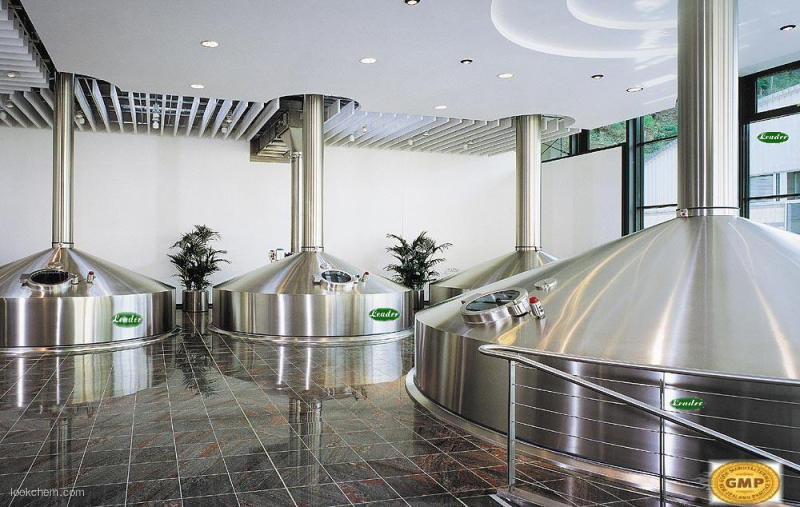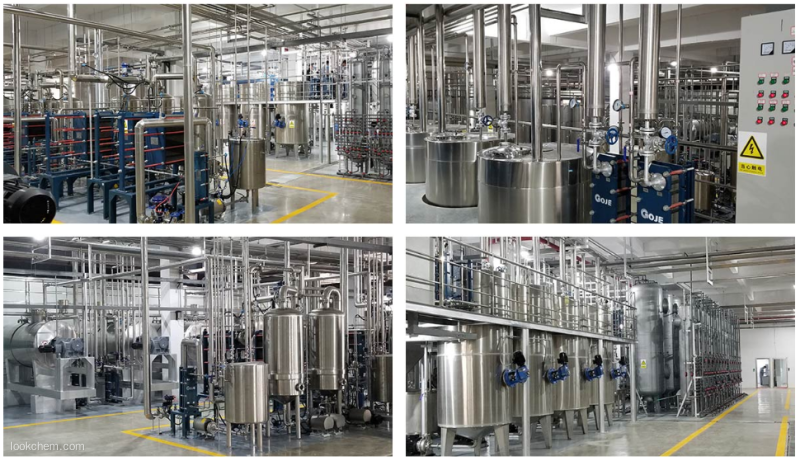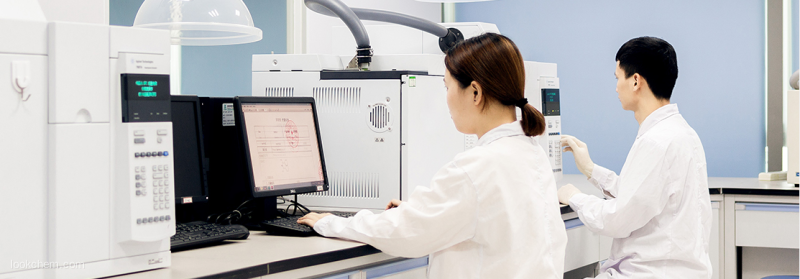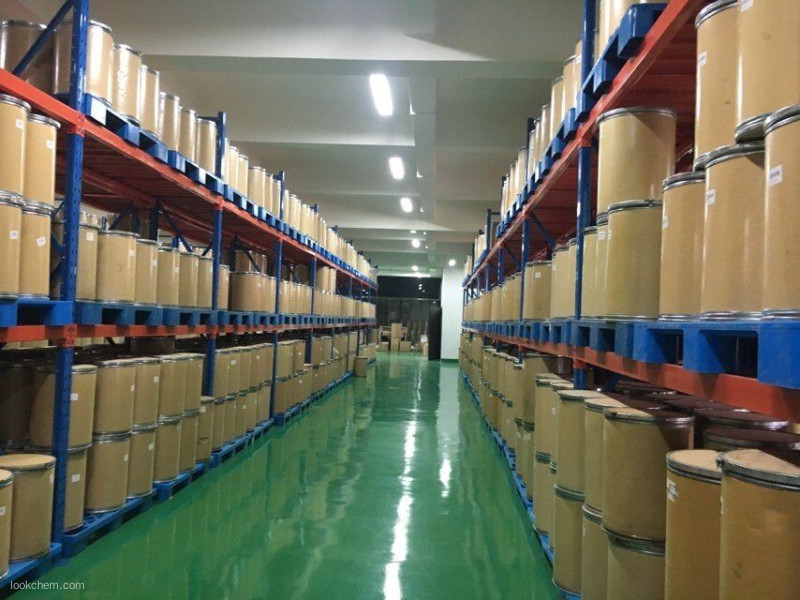PRODUCT DETAILS
| Product Name: |
DL-Dithiothreitol |
| Synonyms: |
DL-1,4-Dithiothreitol, 1M solution in water, for molecular biology;Dithiothreitol ,98%;DL-1,4-Dithiothreitol,DTT;DTT DL-1,4-Dithiothreitol;DL-Dithiothreitol ,99% [for Molecular biology];DL-1,4-Dithiothreitol, DNAse, RNAse and Protease free, for Molecular b;DL-1,4-Dithiothreitol, DNAse, RNAse and Protease free, for Molecular biology, 99+% 1GR;DL-1,4-Dithiothreitol, for biocheMistry, 99% 1GR |
| CAS: |
3483-12-3 |
| MF: |
C4H10O2S2 |
| MW: |
154.25 |
| EINECS: |
222-468-7 |
| Product Categories: |
Chemistry;Test Reagents;Cleland's Reagent;Life Science Chemical Reagents;proteinmod;Disinfectants;APIS;Protein Modification Reagents;3483-12-3 |
| Mol File: |
3483-12-3.mol |
 |
| |
| DL-Dithiothreitol Chemical Properties |
| Melting point |
41-44 °C(lit.) |
| alpha |
-0.2~+0.2°(20℃/D)(c=5,H2O) |
| Boiling point |
125 °C |
| density |
1.04 g/mL at 20 °C |
| vapor density |
5.3 (vs air) |
| refractive index |
1.5200 (estimate) |
| Fp |
>230 °F |
| storage temp. |
2-8°C |
| solubility |
H2O: 50 mg/mL, clear, colorless |
| pka |
pK1:8.9 (25°C) |
| form |
Powder |
| color |
White |
| Odor |
Unpleasant Odor |
| PH |
4.0-6.0 (20-25℃, 0.1m in H2O) |
| PH Range |
4 - 6 at 15,4 g/l at 25 °C |
| Water Solubility |
freely soluble |
| λmax |
λ: 260 nm Amax: 0.400
λ: 280 nm Amax: 0.100 |
| Sensitive |
Air Sensitive |
| Merck |
14,3376 |
| BRN |
1719757 |
| Stability: |
Stability Stable, but heat sensitive. Incompatible with strong oxidizing agents. Keep frozen at -20 to -10 C. |
| InChIKey |
VHJLVAABSRFDPM-UHFFFAOYSA-N |
| CAS DataBase Reference |
3483-12-3(CAS DataBase Reference) |
| NIST Chemistry Reference |
2,3-Butanediol, 1,4-dimercapto-, (r*,r*)-(3483-12-3) |
| EPA Substance Registry System |
1,4-Dithiothreitol (3483-12-3) |
| Provider |
Language |
| ACROS |
English |
| SigmaAldrich |
English |
| ALFA |
English |
| |
| DL-Dithiothreitol Usage And Synthesis |
| Common reductant |
DL-1, 4-DL-1, 4-Dithiothreitol is a common reducing agent, also known as DTT with a strong reduction capability. Its reduction capability is largely due to the conformational stability of the six-membered ring (containing disulfide bone) of its oxidation state. The reducing capability is affected by the pH value and also takes effect only in the case of a pH being greater than 7. This is because it is only the deprotonated thiolate anion (-S-) that is actively in reduction reaction while thiol (an-SH) is not; and the pKa of mercapto group is typically around~8.3.
The reduction of the disulfide bond mediated by DL-1, 4-Dithiothreitol mainly consists of a two-step continuous sulfhydryl-disulfide exchange: wherein the intermediate state formed by the first step of the reaction is very unstable because the secondary sulfhydryl group of DTT tends to connected by the oxidized sulfur atom, making the intermediate state be rapidly converted to the cyclic oxidation structure of DTT, thus completing the reduction of disulfide bonds.
Since being easily oxidized by air, the stability of DL-1, 4-Dithiothreitol (DTT) is relatively poor; frozen storage or processing in inert gas can extend its duration life. Owing to the low nucleophilicity of the protonated sulfur, with the decreased pH value, the effective reducing capability of DTT is also reduced; Moreover, Tris (2-carboxyethyl) phosphine HCl (TCEP hydrochloride) can be used as the substitute of DTT at low pH value and is also more stable than DTT.
DL-1, 4-Dithiothreitol has an antioxidant property that can protect the reductive groups on the enzyme molecules and maintain a reducing environment and stabilize the enzyme activity. DTT also contain certain RNase inhibitors which can inhibit the enzymatic activity of RNase. It has a similar effect as mercaptoethanol (b-mercaptoethanol) but the irritating odor and toxicity of DTT is much smaller and lower than the toxicity of mercaptoethanol. Moreover, DTT has a similar effect as mercaptoethanol even at a concentration of being seven times lower, but the price of DTT is slightly higher. It can be used as the protein thiol group protecting agent and the cleavage of the protein disulfide bond as well as sequence analysis.
Current implemented law regarding the poisons and toxic materials has designated β-mercaptoethanol and reagent-containing β-mercaptoethanol as poison. DL-1, 4-Dithiothreitol has similar effect as β-mercaptoethanol and can protect the SH group of protein, cutting the disulfide bond and therefore will be gradually paid attention by related applications.
The above information is edited by the chemicalbook of Dai Xiongfeng. |
| Uses |
Molecular Biology |
| Chemical Properties |
White crystalline powder |
| Uses |
Dithiothreitol is a redox reagent commonly used as a reducing agent for thiolated DNA. Dithiothreitol is also used to reduce the disulfide bonds of proteins. |
| Uses |
DL-dithiothreitol (DTT) is a sulfhydryl compound that acts both as a reagent reducing disulfide bonds and as a protein denaturant on staphylococcal biofilm (Wu et al. 2011). Thanks to these properties, DTT is routinely used in clinical microbiology to liquefy respiratory specimens, but it has also been proven effective to detach biofilm from orthopaedic prosthesis (Drago et al. 2012, 2013). Since it is crucial to discriminate implant-related infections from aseptic loosening in orthopaedics, and because of the difficulty to diagnose subclinical infections, a prompt diagnosis of indwelling device-related infection is important for successful treatments (Borens et al. 2013). A fast microbiological diagnosis and bacterial identification should be recommended in order to set up a specific antimicrobial therapy. According to this strategy, the bacterial detachment from biofilm on explants should be accelerated by supporting the pathogen viability. |
| Uses |
DL-Dithiothreitol has been added to the samples before loading them for SDS-PAGE (sodium dodecyl sulfate polyacrylamide gel electrophoresis). It has been used in the procedure of in situ hybridization of mRNA.
|
| Definition |
ChEBI: The threo-diastereomer of 1,4-dimercaptobutane-2,3-diol. |
| Application |
DL-Dithiothreitol (DTT) is a chemical debonding technique that also has the goal of driving bacte-ria out of biofilms. A potential advantage of DTT compared with sonication is that tissue can also be evaluated without implants. Drago and col-leagues compared DTT with sonication in patients with prosthetic joint infection or aseptic loosening. Sensitivity was better with DTT (85.7%) versus sonication (71.4%), whereas both had identical specificity (94.1%). DTT had better sensitivity and specificity compared with standard tissue culture. A recent study supports the potential cost benefits of both DTT and son-ication compared with standard culture. |
| General Description |
An excellent reagent for maintaining SH groups in reduced state; quantitatively reduces disulfides. DTT is effective in sample buffers for reducing protein disulfide bonds prior to SDS-PAGE. DTT can also be used for reducing the disulfide bridge of the cross-linker N,N′-bis(acryloyl)cystamine to break apart the matrix of a polyacrylamide gel. DTT is less pungent and is less toxic than 2-mercaptoethanol. Typically, a seven fold lower concentration of DTT (100 mM) is needed than is used for 2-mercaptoethanol (5% v/v, 700 mM).
|
| Biological Activity |
Reagent for maintaining SH groups in the reduced state. |
| Biochem/physiol Actions |
DL-Dithiothreitol denatures proteins by reducing the disulphide bonds and reducing them to SH groups. It also prevents intramolecular and intermolecular disulfide bond formation between cysteine residues of proteins. |
| |
| DL-Dithiothreitol Preparation Products And Raw materials |
|
|
|
|
|
|
|
|
|
|
About US
Leader Biochemical Group is a large leader incorporated industry manufacturers and suppliers of advanced refined raw materials From the year of 1996 when our factory was put into production to year of 2020, our group has successively invested in more than 52 factories with shares and subordinates.We focus on manufacture Pharm & chemicals, functional active ingredients, nutritional Ingredients, health care products, cosmetics, pharmaceutical and refined feed, oil, natural plant ingredients industries to provide top quality of GMP standards products.All the invested factories' product lines cover API and intermediates, vitamins, amino acids, plant extracts, daily chemical products, cosmetics raw materials, nutrition and health care products, food additives, feed additives, essential oil products, fine chemical products and agricultural chemical raw materials And flavors and fragrances. Especially in the field of vitamins, amino acids, pharmaceutical raw materials and cosmetic raw materials, we have more than 20 years of production and sales experience. All products meet the requirements of high international export standards and have been recognized by customers all over the world. Our manufacture basement & R&D center located in National Aerospace Economic & Technical Development Zone Xi`an Shaanxi China. Now not only relying on self-cultivation and development as well as maintains good cooperative relations with many famous research institutes and universities in China. Now, we have closely cooperation with Shanghai Institute of Organic Chemistry of Chinese Academy of Science, Beijing Institute of Material Medical of Chinese Academy of Medical Science, China Pharmaceutical University, Zhejiang University. Closely cooperation with them not only integrating Science and technology resources, but also increasing the R&D speed and improving our R&D power. Offering Powerful Tech supporting Platform for group development. Keep serve the manufacture and the market as the R&D central task, focus on the technical research. Now there are 3 technology R & D platforms including biological extract, microorganism fermentation and chemical synthesis, and can independently research and develop kinds of difficult APIs and pharmaceutical intermediates. With the strong support of China State Institute of Pharmaceutical Industry (hereinafter short for CSIPI), earlier known as Shanghai Institute of Pharmaceutical Industry (SIPI), we have unique advantages in the R & D and industrialization of high-grade, precision and advanced products. Now our Group technical force is abundant, existing staff more that 1000 people, senior professional and technical staff accounted for more than 50% of the total number of employees, including 15 PhD research and development personnel, 5 master′ S degree in technical and management personnel 9 people. We have advanced equipment like fermentation equipment and technology also extraction, isolation, purification, synthesis with rich production experience and strict quality control system, According to the GMP required, quickly transforming the R&D results to industrial production in time, it is our advantages and our products are exported to North and South America, Europe, Middle East, Africa, and other five continents and scale the forefront in the nation, won good international reputation. We believe only good quality can bring good cooperation, quality is our key spirit during our production, we are warmly welcome clients and partner from all over the world contact us for everlasting cooperation, Leader will be your strong, sincere and reliable partner in China.
Group profiles
Our Factories production lines



Our Factories R&D ability


Our Factories warehouse




 Premiumsupplier
Premiumsupplier 



